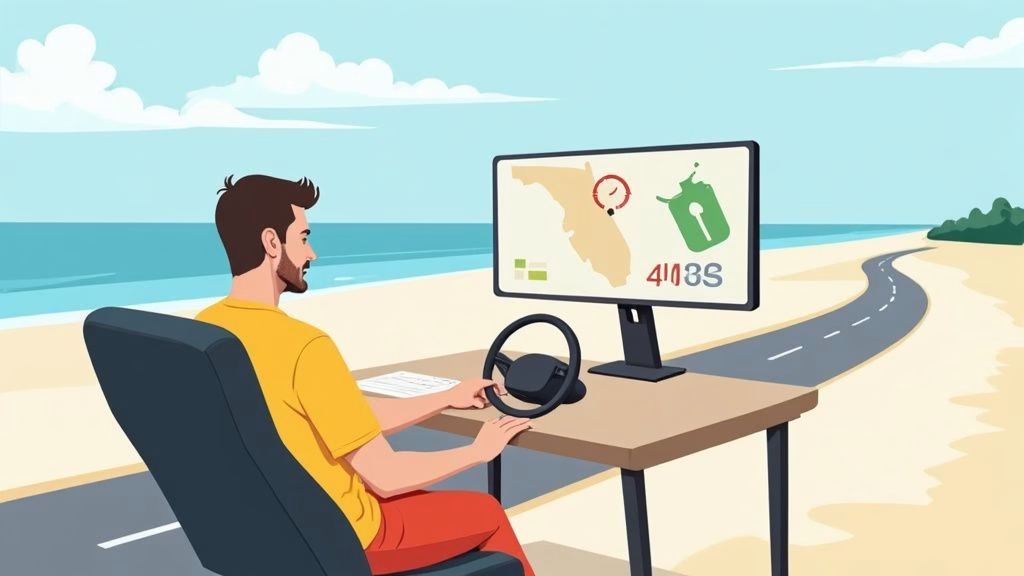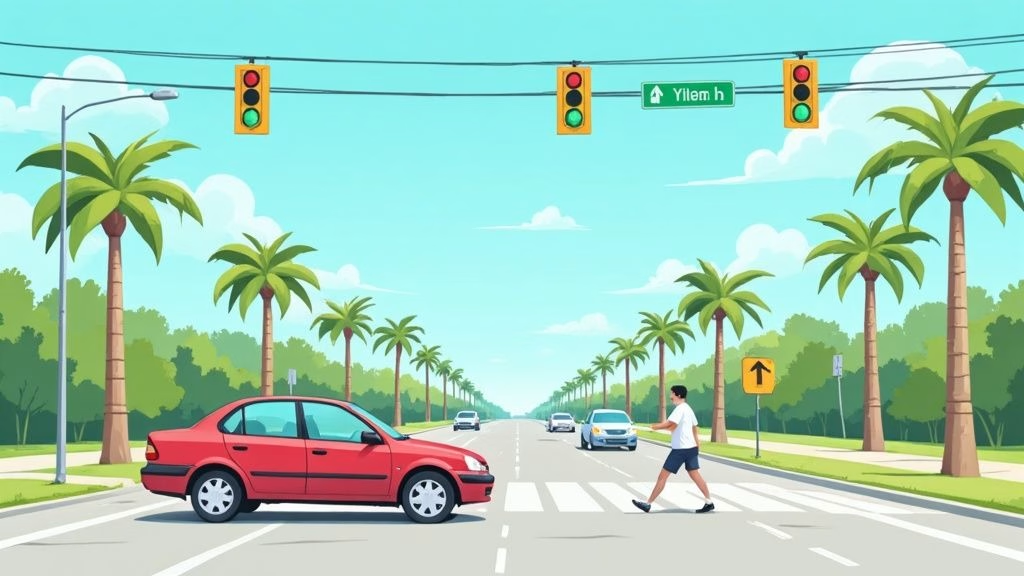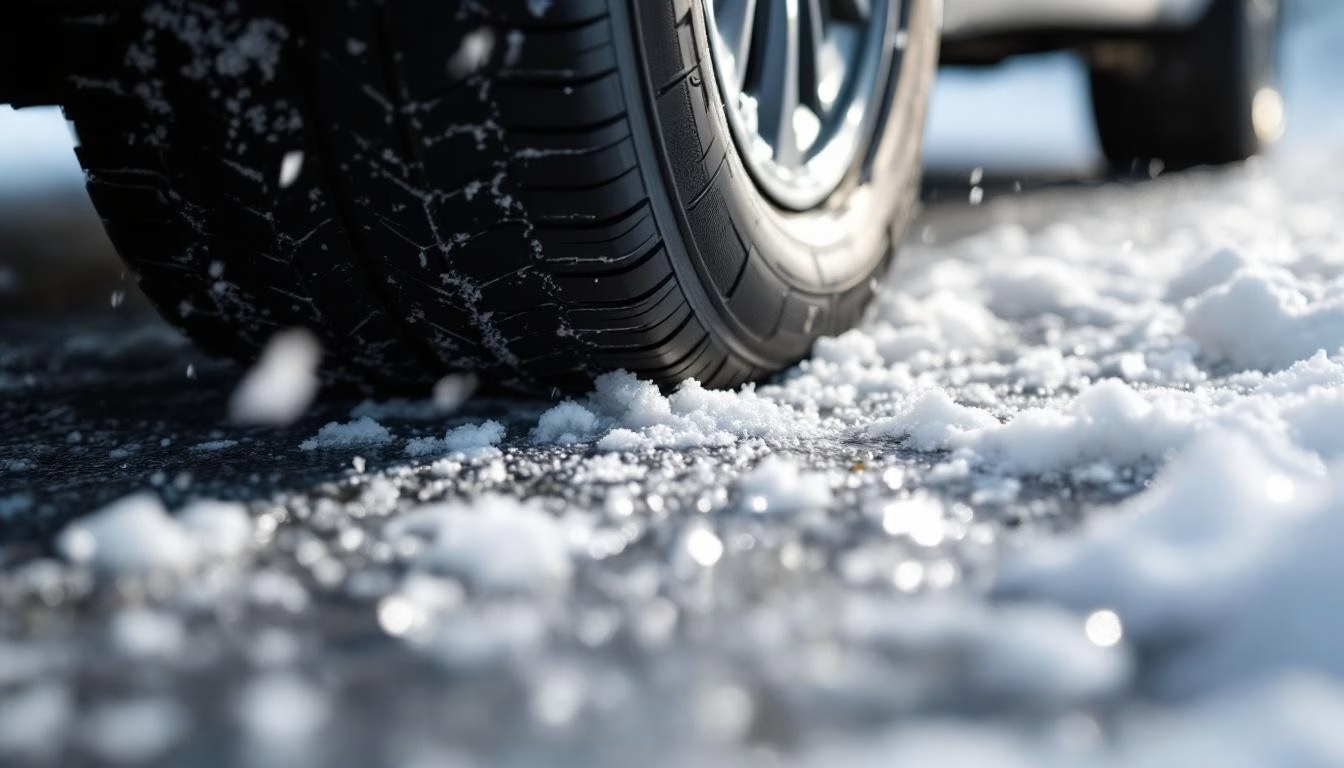Teen drivers face crash rates nearly three times higher than adult drivers, with motor vehicle accidents remaining the leading cause of death for Americans aged 16-19.
Safe driving for teenage drivers requires more than basic vehicle operation skills. At floridanewdriver.com, we know that building lasting safety habits starts with understanding the unique challenges teens face behind the wheel and implementing proven strategies that work.
Why Teen Drivers Face Such High Crash Rates
The numbers paint a stark picture that parents cannot ignore. The National Highway Traffic Safety Administration reports that drivers aged 16-19 die in fatal crashes at a rate of 9.4 deaths per 100,000 licensed drivers, compared to 6.5 deaths for drivers aged 20 and older. The Insurance Institute for Highway Safety confirms that motor vehicle crashes kill more teenagers than any other cause, with 2,116 teen deaths in 2020 alone. These statistics become even more alarming when you consider that teen drivers have crash rates nearly 4 times those of drivers 20 and older per mile driven, making the first year behind the wheel the most dangerous period.
The Science Behind Teen Risk-Taking
Teenage brains operate differently than adult brains, particularly in areas that control decision-making and risk assessment. The prefrontal cortex is one of the last regions of the brain to reach maturation, which explains why some adolescents exhibit behavioral immaturity. Meanwhile, the limbic system that drives emotional responses and reward-seeking behavior matures much earlier, which creates a dangerous imbalance. This neurological reality means teens are biologically wired to take risks and seek thrills while they lack the brain development necessary to fully evaluate consequences. Research from the National Institute of Mental Health shows that teens take risks four times more often when peers are present, which explains why passenger restrictions in graduated driver licensing programs reduce crash rates by up to 21 percent.
Leading Causes That Kill Teen Drivers
Speed kills 32 percent of all teen drivers in fatal crashes, according to the Governors Highway Safety Association. Alcohol causes 17 percent of fatal teen crashes, despite the legal drinking age of 21. Distracted drivers, particularly those who use cell phones, face a 400 percent increase in crash risk. Night hours present another major hazard, with 40 percent of teen driver deaths occurring between 9 PM and 6 AM, even though teens drive only 15 percent of their total miles during these hours.
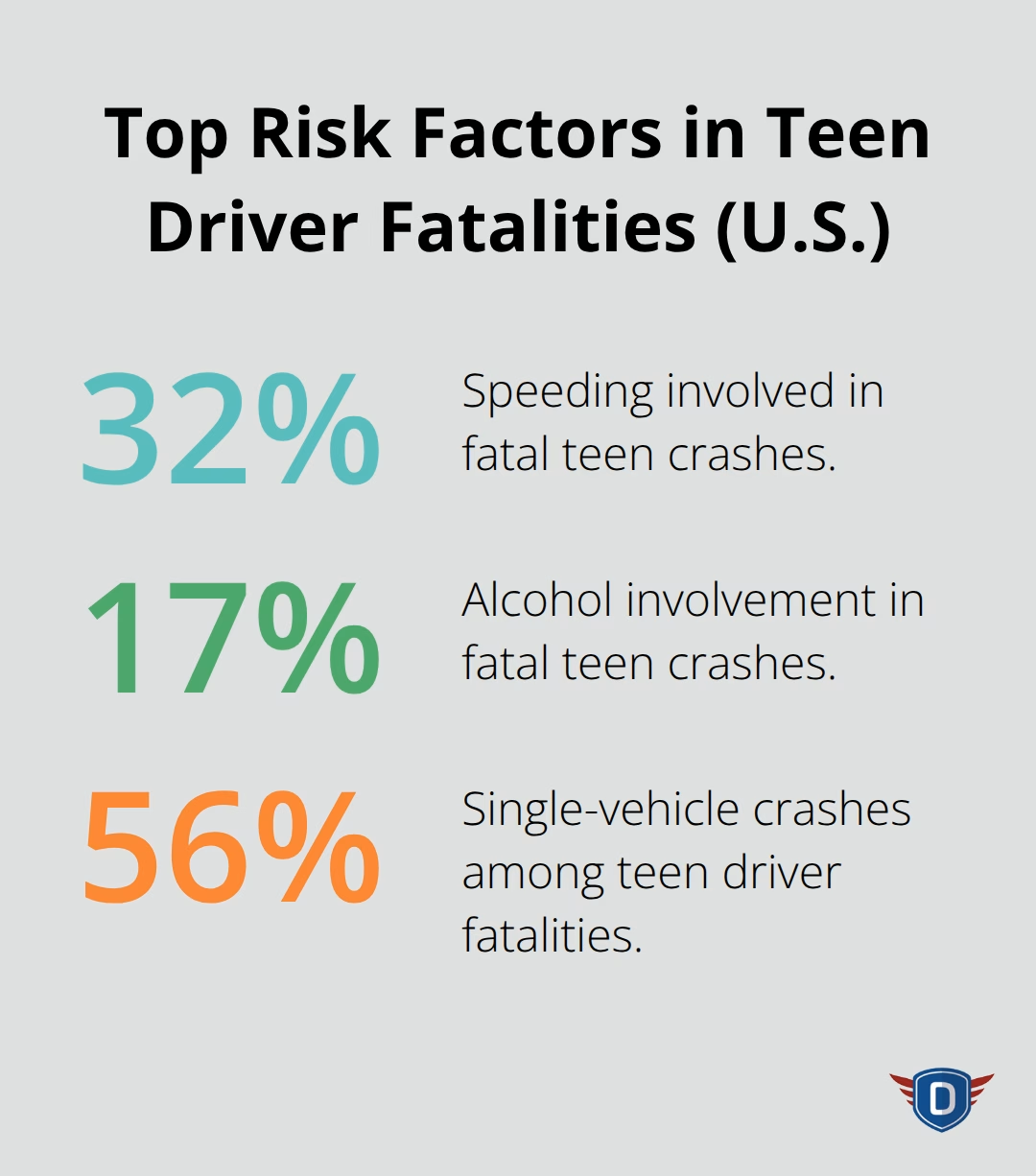
These sobering statistics highlight why teen drivers need specialized training that goes beyond basic vehicle operation. The next step involves teaching specific defensive techniques that can save lives.
What Skills Keep Teen Drivers Alive
Defensive techniques form the foundation of teen driver survival on the road. The National Safety Council reports that drivers who scan ahead 12-15 seconds prevent crashes through these techniques, yet most new drivers look only 2-3 seconds ahead. Teen drivers must learn the 3-second rule as a minimum, with the Federal Motor Carrier Safety Administration recommending 4 seconds in adverse conditions. Space cushion management becomes critical when teens need 40 percent more reaction time than experienced drivers due to inexperience with hazard recognition.
Cell Phone Restrictions Save Lives
Cell phone use multiplies crash risk for all drivers, but teens face even higher dangers due to their inexperience with multitasking behind the wheel. The Virginia Tech Transportation Institute found that texting increases crash risk by 23 times. Parents who implement zero-tolerance phone policies reduce their teen’s crash risk by 70 percent according to the Children’s Hospital of Philadelphia. Apps like DriveMode and AT&T DriveMode automatically disable texting while drivers operate vehicles, though complete phone shutdown remains the most effective solution.
Night and Weather Challenges Require Specific Training
Night conditions kill teen drivers at rates 3 times higher than daytime conditions, with depth perception reduced 50 percent in low-light situations. Rain increases teen crash rates 34 percent, while snow and ice multiply risks 140 percent according to the Federal Highway Administration. Teen drivers need supervised practice in these conditions before they drive alone, with specific training on reduced speed limits, increased distances, and gentle steering inputs.
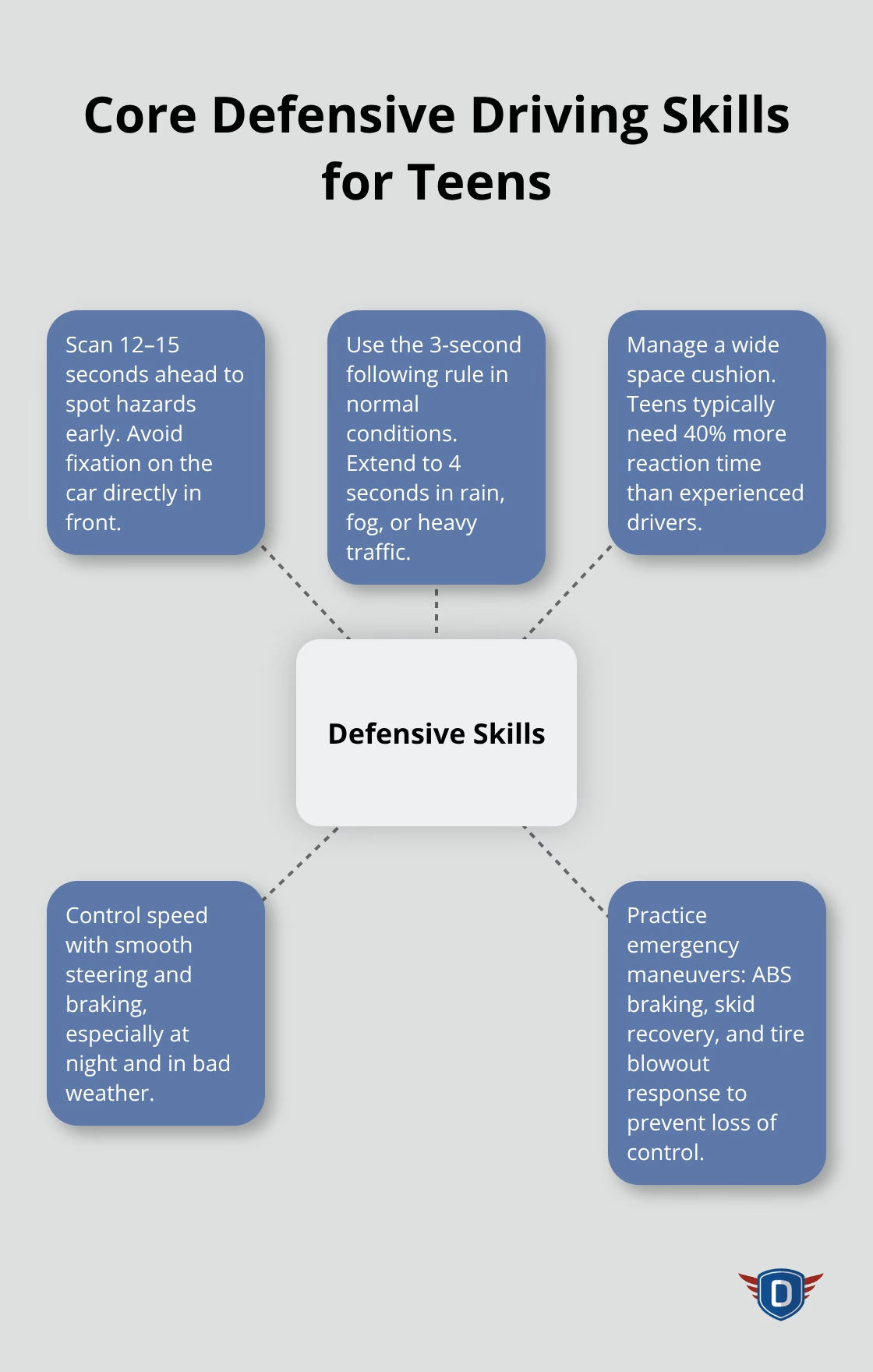
Emergency Response Skills Matter Most
Teen drivers who master emergency maneuvers survive crashes that kill unprepared drivers. Anti-lock brake systems (ABS) require different techniques than standard brakes, yet 60 percent of teens receive no ABS training according to AAA Foundation research. Skid recovery techniques reduce single-vehicle crashes by 35 percent when teens practice these skills in controlled environments. Tire blowout response training teaches teens to maintain steering control and avoid overcorrection, which causes 78 percent of blowout-related fatalities. Accumulating too many traffic violations can lead to license suspension, making safe driving practices essential for maintaining driving privileges.
These technical skills provide the foundation, but lasting safety requires consistent habits and clear boundaries that parents must establish at home.
How Parents Create Lasting Safe Driving Habits
Parents who establish non-negotiable contracts see 40 percent fewer crashes among their teens according to the National Safety Council. These contracts must specify zero tolerance for cell phone use, passenger limits during the first six months, and mandatory seat belt use. The most effective contracts include automatic consequences like loss of privileges for one week after the first violation and two weeks for subsequent violations.
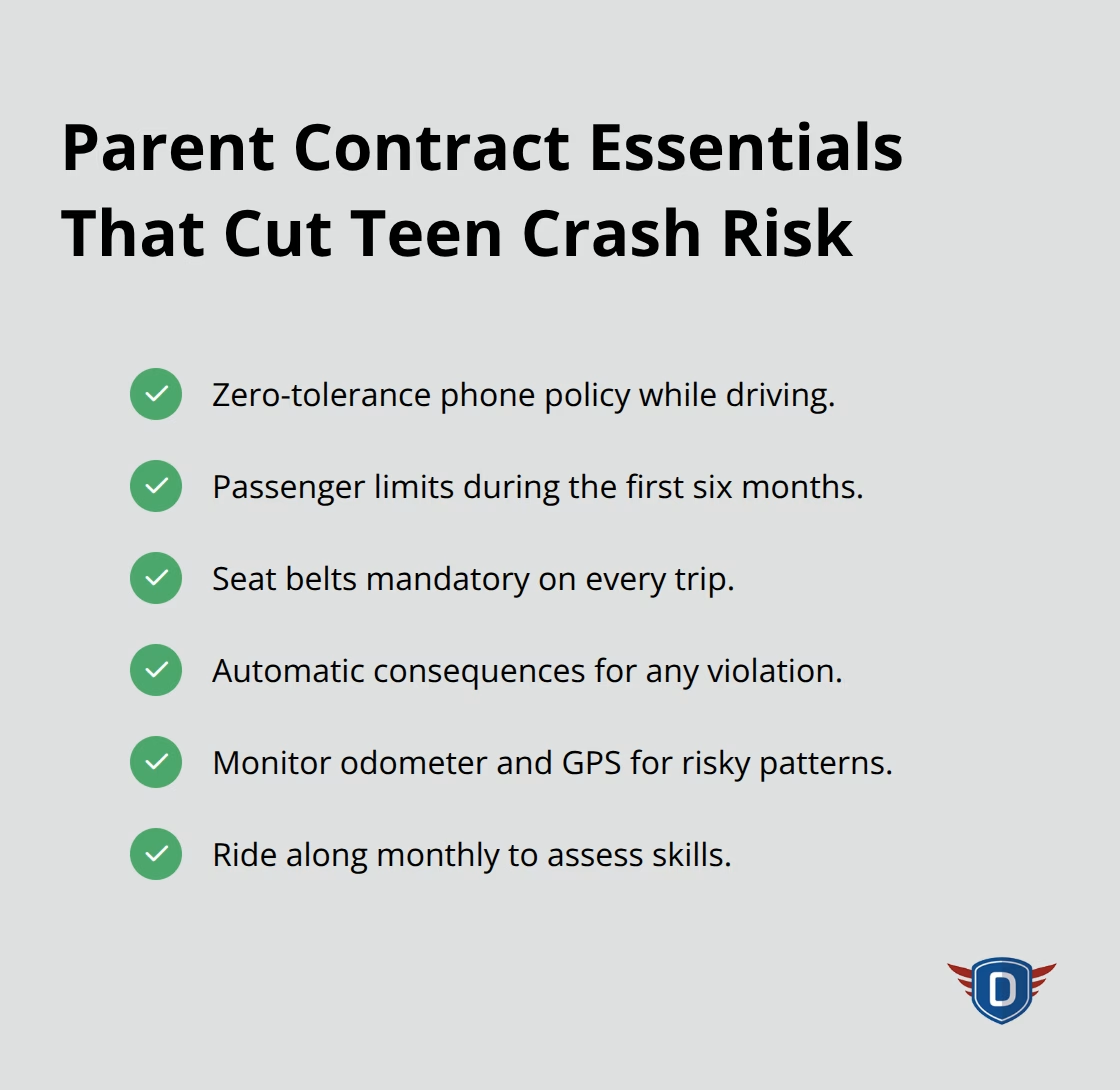
Graduated Licensing Programs Work With Active Parent Support
States with comprehensive graduated driver licensing programs substantially lower fatal crash rates according to the Insurance Institute for Highway Safety. These programs work best when parents actively support the restrictions rather than find ways around them. The three-stage system starts with supervised practice periods of 40-100 hours (depending on the state), followed by intermediate licenses with passenger and nighttime restrictions, then full licenses after 12-18 months. Parents who extend these restrictions beyond state requirements see additional safety benefits, with family-imposed curfews that reduce nighttime crashes by about 10 percent during high-risk hours.
Regular Practice Prevents Skill Loss
Teen skills deteriorate without regular practice in challenging conditions, with crash rates that increase 25 percent after three-month gaps in adverse weather conditions according to AAA research. Parents should schedule monthly practice sessions that include highway merging, parallel parking, and emergency stops throughout the first two years. Professional refresher courses at six-month intervals reinforce proper techniques and introduce advanced skills like skid recovery and collision avoidance. Defensive driving classes can provide structured learning environments that improve safety skills and may offer insurance benefits. The most successful families track practice hours and skill development in logs, treat continued education as seriously as the initial phase.
Technology Tools Support Parent Oversight
Modern technology gives parents unprecedented ability to monitor teen behavior behind the wheel. GPS tracking systems alert parents when teens exceed speed limits or travel to restricted areas, while smartphone apps automatically disable texting functions when vehicles reach 10 mph. Insurance companies like State Farm offer teen monitoring programs that provide monthly driving reports to parents, with premium discounts for safe behavior. Dashboard cameras record both road conditions and teen reactions, which helps parents identify areas that need improvement during practice sessions.
Final Thoughts
Safe driving for teenage drivers demands a comprehensive approach that combines proven strategies with consistent enforcement. Statistics show that teens who receive professional instruction, follow graduated licensing restrictions, and maintain active parent oversight reduce their crash risk by up to 70 percent during the critical first two years behind the wheel. Parents must establish clear contracts, monitor behavior through technology, and provide regular practice sessions to create the foundation for lifelong safe habits.
Parents play the most important role in teen driver safety success. Zero-tolerance policies for cell phone use, passenger restrictions, and extended curfews work when parents consistently enforce these rules without exceptions. The combination of structured oversight and clear consequences creates accountability that teens need during their high-risk early years (when crash rates peak at nearly four times those of experienced drivers).
Professional instruction remains equally important for technical skills that parents cannot teach effectively. Comprehensive driver education programs provide structured environments where teens master defensive techniques, emergency maneuvers, and hazard recognition skills under expert guidance. We at floridanewdriver.com help students develop safety habits that persist throughout their careers, which reduces crash rates and insurance costs while protecting lives on the road.



